Team Analysis: Paris Saint-Germain
Over the past 3 seasons, PSG have come to dominate the French first division and have now all-but secured their 4th consecutive title for 2016. Supported by the riches of Nasser Al-Khelaïfi who bought the club in 2011, the Paris side have assembled a squad filled with excellent players. Over time, this technically-strong side has been molded into a strong possession-based system by Laurent Blanc after Ancelotti’s counter-attacking focus.
Taking over from world-class coach Ancelotti, Blanc has integrated a centrally-oriented system within a 4-3-3 shape. Often becoming a variable 2-5-3 shape in attack, they display a strong building game with a patient development of possession. Higher up, the side show good synergy in combinations and overloads through the centre with the wings being an alternative route through the situationally-ignored full-back.
Across the defence they possess perhaps the best central defender in the world in Thiago Silva who is usually paired with one of David Luiz or Marquinhos. Across the trio, PSG benefit from some excellent playmaking abilities which is an important component of their possession game.
The highly-intelligent Thiago Motta provides valuable stability from the 6 position where he will stay deeper and maintain balance across the shape. To the right of him is usually Marco Verratti, a player crucial to the playmaking with high strategical intelligence. On the other side is Blaise Matuidi, an active player who supports well through the left half-space. In rotation they have Rabiot and Pastore supporting from the sidelines.
PSG possess an array of strong attackers both on the flanks and centrally. Throughout the majority of matches, Zlatan Ibrahimović occupies the central striker role and he has been sided by a range of forwards. Both Lucas Moura and Angel Di Maria, two highly intelligent players have been most common, whilst Edinson Cavani and Ezequiel Lavezzi have too played a part.
In this article I will look to analyse the most important and interesting aspects of PSG’s system, which has seen them achieve a rarely-matched dominance of their domestic league.
Centrally-Oriented Structure as a Framework
As both wide players come inside to converge with a narrow midfield, it isn’t difficult to see a clear central-focus in PSG’s positional structure. Whilst both full-backs advance into high positions off of the ball the two wingers, whether it be Lucas, Di Maria, Lavezzi or Cavani, all look to move inside around their respective half-space.
In doing so, PSG adopt a strong central presence which is crucial to their overloads and combinations; something I will come to discuss later within this article. With often 4 or more players positioned within the three central columns of the pitch, they create a strong access into the spaces between the lines.
On a more general sense PSG’s spacing is often strong and particularly so from half-space to half-space. This allows the team to generate high levels of good connections around the ball which supports with greater passing options, higher variability and collective pressing-resistance amongst other benefits.
The connections created through this centrally-focused shape gives PSG stability in possession. Not only do they generate options around the ball well, but their shape theoretically facilitates defensive access for the counterpress on the turnover of possession.
The spacing is quite variable and has great flexibility across the midfield and front three. Positional rotations occur regularly between the midfield with Motta and Verratti alternating between positions quite often in build-up. In contrast to some teams whose collective positioning can be much more rigid and invariable, PSG are given somewhat of a freedom within the structural scheme.
There is a distinct example of position variability when observing the orientation of the wingers. With the exception of Cavani, they play a crucial role in PSG’s possession game and lack a single fixed position, possessing the potential to shift between multiple roles.
The movements can be divided between two groups. Firstly, the wingers can position themselves high up on the defensive line in one of the half-spaces. Here they threaten with movements in behind with which they can not only push the defensive line deeper, opening space for the midfield, but potentially receive a through-ball in behind as shown in the example below.
https://twitter.com/TomPayneftbl/status/698200946220916736
Alternatively, they can move closer towards the midfield where they will support the connections through the midfield and offer themselves in combinations. The overloads created through this can also lead to players becoming free to progress possession past the midfield line. Meanwhile between the two, Zlatan Ibrahimovic drops frequently though to limited success as the Swede doesn’t display a level of team-tactical intelligence necessary to aid through his positioning and contribution to ball circulation.
This positional variability resides between guidelines set by Blanc as the French coach shows trust in his players, giving them freedom to make a decision on their own positioning. Guidelines such as the central-focus and collective-orientation act as a basis for the players to play with and from this they can implement their own team-tactical intelligence in the game. The result of this is a balanced system as Blanc has refrained from imposing an over-bearing structure and instead allows his side to use their improvisational abilities.
Especially considering the team-tactical intelligence of players such as Motta, Verratti and Di Maria, it would’ve lacked sense to make them slaves within a system where they cannot deviate and express their abilities.
With a lack of fixed positioning, they work well to act as the free man in central positioning due to their freedom to move away from their space to drop into open gaps in other areas of the defence. This occurs quite regularly, allowing PSG to find access between the lines, beating the opposition’s midfield line with a precise penetrative pass.
Due to the somewhat free-form nature of PSG’s positional structure, their spacing lacks a high level of consistency. Obviously this has large strengths, as it reduces the predictability of their game and allows them to adapt themselves to specific situations when required.
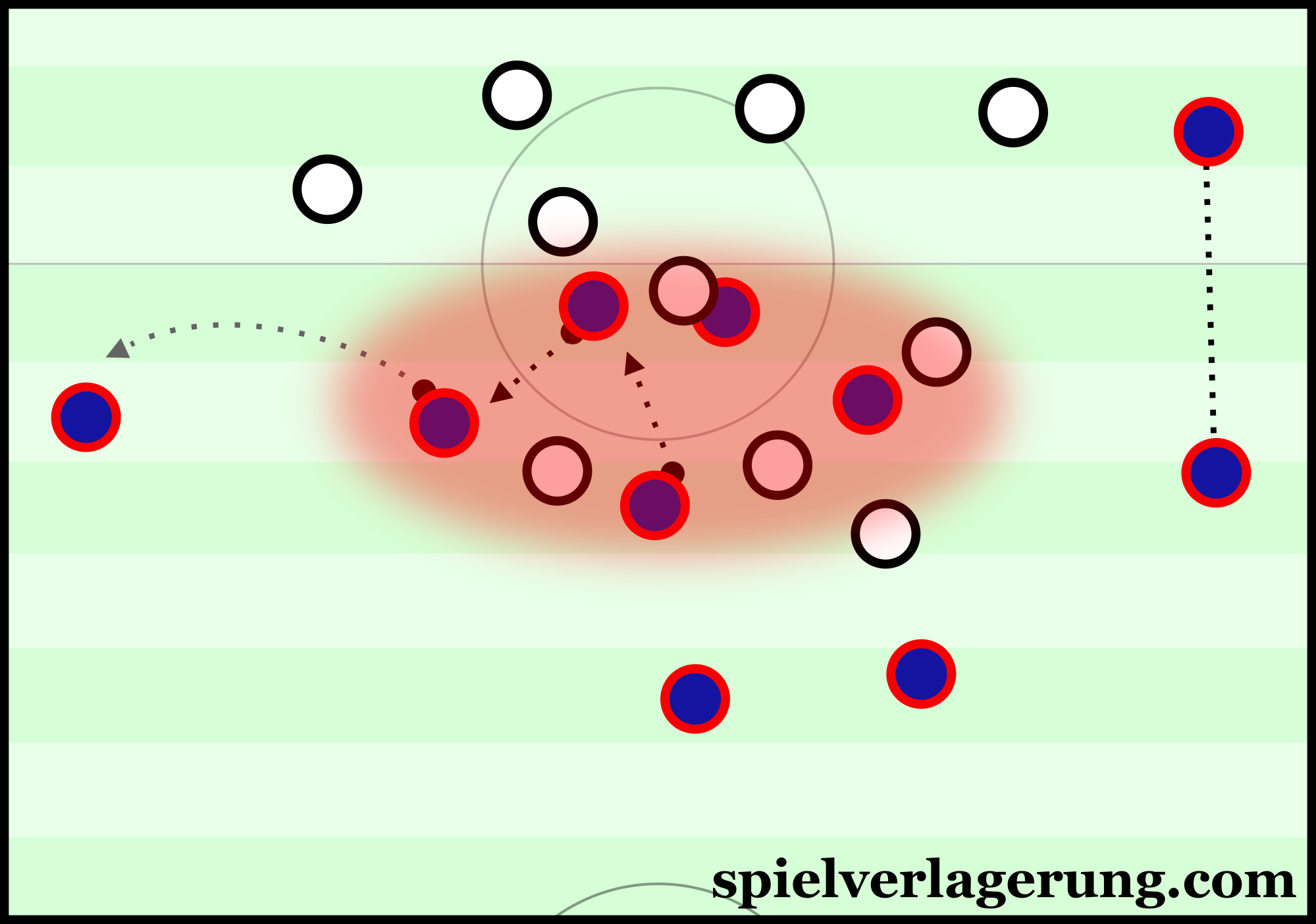
PSG showing weak structuring in their recent match with Lyon. There is only one clear forward pass available and even that has limited potential.
However, in some situations it does have some negative implications. Due to the impossibility of a perfect synergy, there are scenes where the team are structurally-imbalanced and have a weak shape in possession. In these situations, particularly in the league, the movements aren’t at a high intensity and the time it takes for them to restructure themselves into a stronger position can be quite long.
This happens commonly upon regaining possession of the ball too. Due to their man-orientated defense, their shape upon turnover of possession can be quite weak for immediate circulation and they are then slow to amend this. As a result, their play in transition has potential weaknesses though it has yet to be consistently exploited.
Collective-Oriented Possession Game
With players such as Angel Di Maria and Thiago Motta, it is no surprise to see a sizable collective-orientation in possession from PSG. With the ball, nearly every aspect of their game is focused around using strong teamwork to destabilize the opposition defence and ultimately create chances.
Immediately it becomes evident to the eye when you observe the Parisian positional structure which facilitates high levels of connections for team to co-ordinate attacks together. This factor has a large influence on their combination play which itself is a large component of their possession game. Through exchanging short passes quickly between a group of players, they’re able to move the ball through an opposition defence as a group.
In somewhat of a similar fashion, this orientation is very similar to a team I previously analysed in Borussia Dortmund. Based around juego de posición, Dortmund also use frequent combinations to break through and overload well to create free men within the opposition defence.
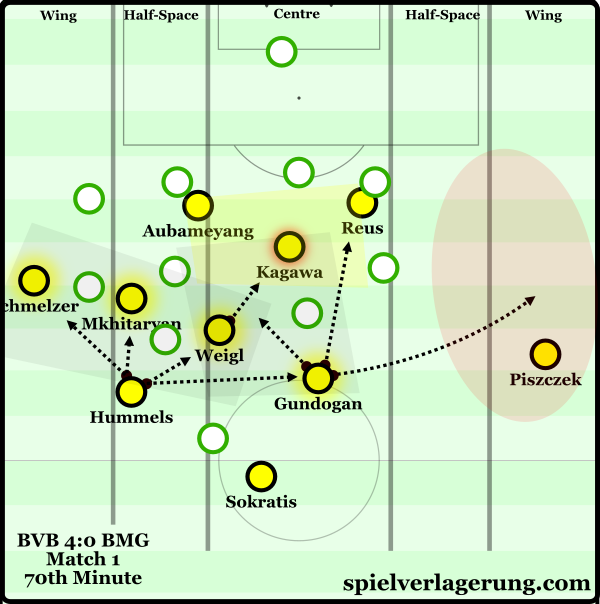
Dortmund have played at an exceptionally-high level this year through the introduced concepts of Thomas Tuchel. Click on the image to be taken to my team analysis of them!
Within the possession game, there is a distinct lack of individual attempts to break the lines. Dribbles and isolations are out of favour compared to the above-mentioned overloads and combinations as PSG play to the strengths of players such as Verratti and Lucas.
Not only would an individual focus, such as Crystal Palace’s iso-ball-like playing style which I analysed mid-late 2015, not suit the PSG players well, but theoretically it has its limitations too. When a team looks to make an attack through just one individual, the attacking potential (not just in the threat but potential in terms of strategical possibilities too) is immediately limited to a considerable degree.
On the other hand, an attack involving three or more players will usually provide the team with many more strategical devices to destabilize the opponent’s defensive organization. This is largely due to the fact that an increased number of players can collaborate and offer different playing styles and attributes. In addition, some actions, such as combinations simply require multiple participants.
This is relevant even during attacks on wide areas; though the ball is in a position where it usually has the least amount of connections and supporting players. PSG still look to use (albeit smaller-scale and less complex) quick combinations and through-balls through the channels to break through the opposition defence.
Combinations: A Means of Penetration and Pressing-Resistance
Not only are they of great aesthetic value, but PSG use combinations as an extremely effective tool to support their possession game in multiple aspects. With highly skilled and intelligent players in the centre, they’re able to move the ball at high speeds with fast successive passes through opposition defences
The likes of Marco Verratti and Angel Di Maria utilize their skillsets near-perfectly during these situations as they allow PSG to quickly progress the ball with combinations at a very-high level.
By making such combinations, PSG primarily find benefits in two facets of their possession game.
Firstly, the combinations provide a means for Verratti and co. to develop a strong resistance against opposition pressure. Through the quick movement of the ball between players, PSG can rather comfortably retain the ball in high-pressure areas which then heightens their potential to create too.
https://twitter.com/TomPayneftbl/status/698186055929954304
When watching the side, it is common to see them seemingly-effortlessly circulate the ball through the midfield as the opposition struggle to create, let alone develop, defensive access. The ball is difficult to track as it rapidly switches between players and its constantly-changing position makes it extremely challenging for the opposition to apply pressure.
Secondly, PSG use combinations as a dangerous tool to break through the opposition’s lines of defence and create dangerous situations. With strong forward movements and the support of higher-positioned attackers, they’re particularly good at creating small-scale overloads in midfield to carry the ball through.
https://twitter.com/TomPayneftbl/status/688120238139768833
It is within these small overloads that Paris can carry the ball and combine to break the oppositional lines of defence. This is often done in the midfield where they can particularly take advantage of weak staggering across the line. They are also a very effective way of preparing a penetrative pass, with the fast movement of the ball offering a way to destabilize the opposition and thus open passing lanes.
https://twitter.com/TomPayneftbl/status/698165614762991616
Obviously the two are far from exclusive and are closely related on the pitch. It is through restricting the opposition’s access to apply effective pressure which opens many of the opportunities to then play the penetrative pass which leads to chances.
Through this high level of combination play, PSG can add to their individual pressing-resistance with a strong collective pressing-resistance too. Whilst the individual pressing resistance is brought about through their needle players, their combinations as well as the effective spacing makes them difficult to press as a collective too.
Integration and Utilisation of Playmaking Centre-Backs
In addition to the likes of Marco Verratti and Thiago Motta, PSG have some very strong ball-playing centre-backs. Thiago Silva in particular shows impressive distribution, providing a valuable alternative in their building game. Even if a team is able to shut down Verratti and co. they struggle to enforce the same restriction on the centre-backs who are then more free to show-off their passing abilities.
https://twitter.com/TomPayneftbl/status/698137328238358532
During PSG’s build-up the team can actively look to integrate their centre-backs for their passing ability and do so quite well. Particularly against a 1-striker defensive block, they will look to free up a centre-back who can go un-pressed to then break the lines of defence.
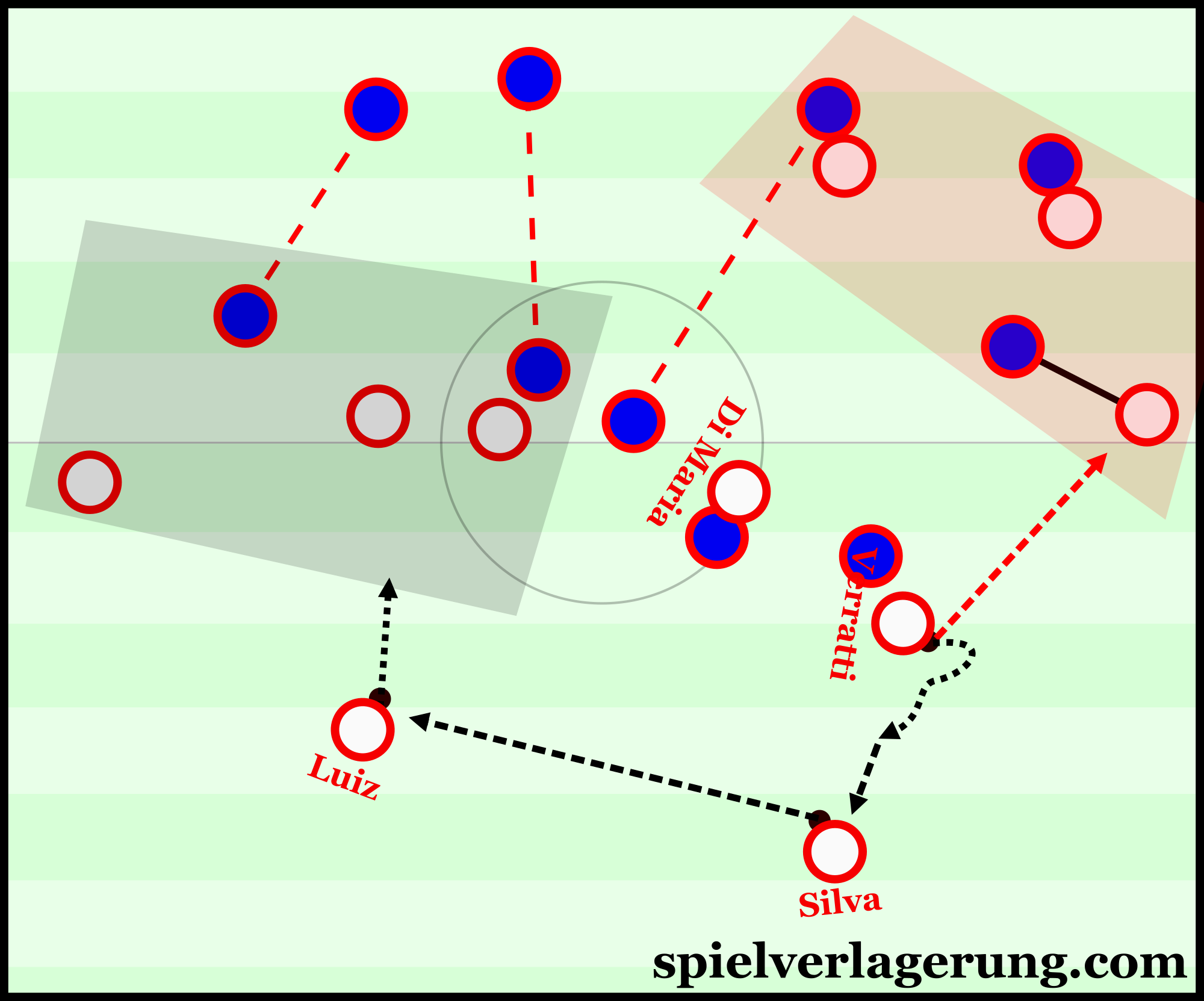
David Luiz is given space to drive forward with the ball after Verratti attracts pressure to the opposite half-space.
This is best done through their horizontal circulation of the ball as they switch well from half-space to half-space. When they have possession in the left half-space, they often use this situation to attract pressure from the striker to then switch towards the right where Silva is positioned. This gives the captain with ample time to progress the ball forward and then find the likes of Di Maria or Lucas between the lines.
The position of the half-space also provides benefits as it provides variability in a team’s building game. The two directly adjacent columns to the half-space is a wing and the centre, which possess quite contrasting values. Whilst the centre is a generally one of the best places to be in, the wing is much weaker and the defence are trained to shift across and stay compact. Because both spaces are within immediate reach from the half-space, the defence are worse at preparing themselves for the opposition’s next move.
Their playmaking centre-backs is a valuable tool especially against man-marking as they can often exploit the opposition’s man-to-man focus. Many teams have come up against Blanc’s side and looked to mark the likes of Verratti out of the game. However it is much less orthodox to make such an attempt on the central defenders and they can often find themselves free in possession.
Stable Man-Oriented Pressing
Without possession, Paris have a strong and organized defence which has one of the best clean-sheet records in Europe. They employ a man-oriented scheme which allows them to have good access in pressure whilst maintaining stability due to its flexibility.
Blanc’s side aggressively search to regain the ball by playing a man-oriented defence which sees many man-to-man situations, particularly in the opposition half.
This flexibility is in some form a result of their strong use of cover shadows when looking to press the opposition. Through using body position to cover a player behind them, a player can apply good pressure on the ball-carrier whilst maintaining cover of another. This defending of two players simultaneously provides benefit higher up as they can theoretically form numerical superiority.
Another important aspect is their clever use of spacing between a marker and his opponent. In less important spaces in relation to the ball, a marker will distance himself well from his marker and instead position himself in an open space which requires covering. Through doing this he maintains access to his man whilst supporting the spatial compactness and provides important spatial cover which is otherwise difficult to achieve in a man-oriented system.
In some matches against the more tough opposition of the French league as well as in Europe, PSG have seen some issues in their man-oriented defence exposed.
On the 4th of October 2015 for example, Blanc’s side managed to overcome Marseille at home on a 2-1 scoreline and the away side threatened through creating open spaces in PSG’s defence.
Míchel’s team played with some strong movements off of the ball to manipulate PSG’s shape and reduce their defensive stability. As you can see in the example above, their midfield loses it’s shape completely as they move out to press the ball and cover deeper Marseille players. In doing so they leave the right half-space completely exposed and open for a vertical pass.
Although their intelligence is important in maintaining stability with the man-oriented defence, the reactivity and typical components of the scheme can still prove to be troublesome.
In their 1-0 win over PSG, Real Madrid were able to find players in gaps within the PSG block through some simple movements as the wide players would cut in to the centre off of the ball. Reluctant to follow their man inside, the full-backs would generally maintain a wide position and as the PSG midfield were concered with stopping Modric and Kroos, they relinquished some cover of the 10 space.
Imperfections
Despite their dominance of France, Blanc’s side are far from perfect and there are some flaws within their tactical system.
Although the structuring is largely strong with good spacing and connections through the middle, the inconsistencies can have negative effects on the team’s possession game. It isn’t rare to see two or more players occupying the same zone and sub-par spacing through the middle of the pitch. This seemingly stems from their somewhat free-form positional game which will subsequently suffer when the co-ordination is lacking between the players.
Aside from this, the performances can be rather inconsistent between matches, something which has been more apparent in recent weeks. The side are often affected quite significantly if they happen to be missing a key player which has lead to some weak performances in recent Ligue 1 matches.
As Blanc’s side have been without Marco Verratti in recent games they have looked much weaker in possession of the ball. Usually with Stambouli into the side, they have suffered with less balance and a much weaker circulation as the ball moves with less of an intensity whilst they struggle to move into central areas.
This was particularly noticeable throughout two recent games against Lyon and St Etienne. Despite winning both games, they were far from their usual performance levels and particularly looked a depleted side in the first half against Lyon. It was interesting to see what seemed to be a strategical shift in the absence of Verratti against Lyon, as PSG were noticeably more wing-oriented in both build-up and attack and crosses ultimately featured in two of their three goals.
Finally, PSG have a tendency to lack intensity in possession of the ball and they are slow in circulating the ball from build-up to the final third. This seems related closely to the above issues, as Verratti proves to be a pivotal component in their ball movement whilst structure has close links to the circulation too.
A positional structure is integral to the circulation of the ball simply as the ball is passed between players, thus the positioning of said players has a telling impact. When the spacing is weak and the distances are either too close or too far away, the circulation suffers with less connections for the ball to move through whilst if PSG don’t have free men in the defensive gaps, there is no way for the ball to move there.
Take the above image for example, with a lack of distance between the 5 central players and minimal connections being made between them, it is difficult for PSG to effectively move the ball upfield. There is only one clear option to move the ball forward and from that route there is only limited attacking potential with the ball likely moving to the wing. I took this example from PSG’s above-mentioned clash with Lyon as they clearly struggled without Verratti.
Marco Verratti
It would be near-impossible to make an analysis of this PSG side without particular recognition of a player so crucial to their possession game. Over the years since signing for the club from Pescara in the summer of 2012, the small midfielder has further developed his excellent skills in possession.
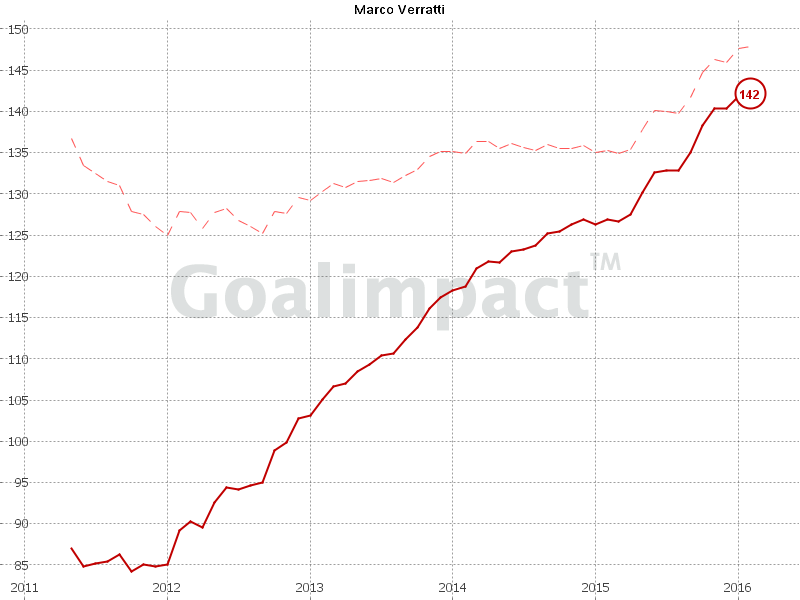
Marco Verratti’s goalimpact, thanks to Jörg of @goalimpact for giving me the use of these graphs. Click on the image to be taken to his twitter!
Playing Style
From the right side of the Paris midfield, Verratti is very much a unique footballer with few similar across the top leagues of Europe. Through his regular (but pragmatic!) use of flicks and elusive dribbling, the Italian is a most entertaining midfielder despite being simulatenously effective in his game.
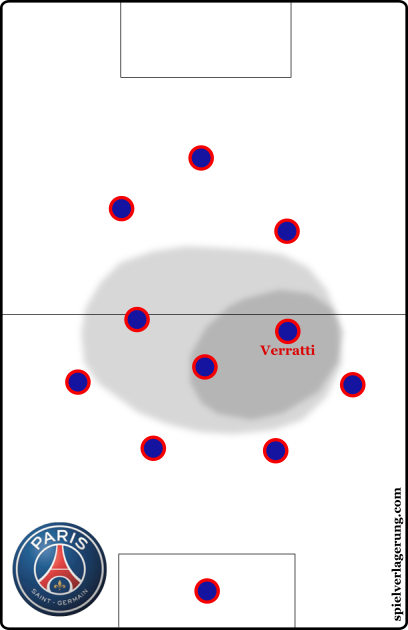
Verratti’s far-reaching involvement in possession. The darker area is the primary space he acts in, whilst he commonly moves through the lighter area too.
Within PSG’s system, he is crucial to the circulation of the ball and is very ball-oriented in his movement as he constantly looks to be in possession, often moving away from his right half-space berth. With his frequent movements towards the ball, he has a high influence in the system and will impact the circulation of the ball in nearly all areas across the width of the pitch.
At times he can come across as reckless as he takes massive risks within the PSG third, often looking to dribble his way out of heavy pressure on the edge of his own box. However it isn’t often he is caught out due to his resistance to pressure and instead he creates the potential for some counter-attacking situations after beating the counterpress.
Ball Retention
In some ways reminiscent of Busquets or Xavi, he displays excellent retentive skills which allow him to maintain possession of the ball under high pressure. Considering his importance to the team’s ball circulation, his pressing resistance is of heightened importance as he is often the target for specific defensive pressure.
With strong dribbling ability, the Italian can often evade tackles and opposition pressure by weaving the ball out of the way. Verratti rarely uses dribbling ‘moves’ and instead uses his excellent close control and intelligent use of body shape to shield the ball and keep the ball out of reach.
His use of flicks and disguised passes helps in these tight situations too. The midfielder uses backheels and similar disguised passes in order to deceive the opposition defence with a high unpredictability. In other cases, he will use small touches such as a drag-back before making a pass to refine his angle and to evade a defender’s reach.
It must be noted however, that there is a clear pragmatism surrounding these small tricks and Verratti rarely will make one of these flicks if it didn’t serve as a strategical tool. His disguised passing is an excellent means of developing pressing resistance as he is very difficult to predict from a defensive perspective. The opposition cannot prepare for just one or two options as you can be sure that Verratti will uncover a third.
Positional Intelligence
The intelligence of the midfielder can also be seen in his positional play. When he himself is not in possession of the ball, you are likely to see him support his teammates by moving to manipulate the opposition block, open passing lanes and create space for others.
Considering the ball-playing ability of players such as Thiago Silva, this is an important facet which Verratti brings to the PSG system as he helps them exert their own playmaking abilities. Furthermore, his positional play can have a greater impact than most as opposition teams tend to develop a higher focus on the short Italian as opposed to other teammates.
https://twitter.com/TomPayneftbl/status/689042859350208512
Although at times barely noticeable, Verratti’s intelligence in his positioning is an integral part of his game. Whether he is using his positioning to heighten the effectiveness of teammates, or to open passing lanes as shown in the above .gif, Verratti’s high footballing IQ is crucial and a valuable playmaking tool for Blanc’s side.
An example of positional support can be seen on the left. In the beginning of this scene, PSG’s spacing is poor with a lack of distance between the ball-near trio and as a result, Saint-Etienne can press with some effectiveness.
Verratti seemingly understands this and after giving the ball to Motta, he backs away to increase the distance to the ball and improve the spacing to some extent. This then forces the left-most Saint-Etienne midfielder to cover slightly more space and he doesn’t react quick enough.
Upon receiving the ball back from Motta, Verratti is now in a position to make a pass behind the Etienne midfield and can access Motta who has moved behind uncovered. The opposition defensive shape is now opened up with a number of different attacking options for PSG going forward.
He also has a great sense of awareness on the pitch. His sense of teammate positioning is at an elite level as he commonly makes seemingly-blind passes which great accuracy.
Playmaking
Another component of his playing style is his strong passing range and ability. As I discussed in an above section, PSG use direct balls from build-up quite regularly as an alternative to their usually-short game. In search of movement in behind from the forwards or potentially a free full-back attacking wide spaces, Verratti can utilize his impressive passing range to progress the possession quickly and potentially catch the defense by surprise.
https://twitter.com/TomPayneftbl/status/698141186977087488
In the above scene he shows off his terrific passing intelligence and allows PSG to bypass any oppositional pressure and then create access into the 10 space as they can break through the midfield lines. The video also highlights Verratti’s far-reaching influence as his ball-oriented movement has found himself in the opposite half-space to his usual position.
His most dangerous pass is a brilliantly-accurate lofted through-ball over the defensive line which consistently finds the feet of Ibrahimovic or Lucas running in behind. It is a pass he often looks for when he possession in a central position, particularly when the opposition lack access.
The Italian is also strong in his short passing which lends itself excellently to the combinations which take place through the midfield. Particularly given his ball-oriented movement which sees him involve himself in most plays, Verratti’s short passing is used constantly to aid his team’s combinations through the centre. It is in these moments where his clever flicks and other disguised passes can be utilised as he brings others into play.
When he is not aiding in short combinations through the midfield line, he can also contribute in alternative ways through sharp penetrative vertical passes. With the central-focus of the positional structure and the forwards-moving Matuidi, Verratti can provide a means of central access through his strong passing game.
Importance
Verratti’s importance to PSG’s possession game was evident in their recent 2-0 win over Saint-Etienne. Blanc started with the Italian on the bench as he opted for Stambouli alongside Matuidi in the right 8 position.
For the first 70 minutes of the game, they looked notably unbalanced in midfield and struggled in circulation as the opposition held them to what was potentially a scoreless game. Upon the introduction of Verratti however, PSG’s playmaking improved considerably as their ball circulation was more fluid and they had greater rhythm in their attacks. In one of his first actions, Verratti played a part in the first goal and then saw the team score again later on in the game.
Conclusion
Through the 15/16 season, Blanc has proven that his PSG side are amongst the elite of Europe, with only Barcelona and Bayern Munich clearly ahead. It would be easy to attribute their dominance to a weak domestic competition however I suggest that the Parisian club are a force to be reckoned with for the remainder of this season. A major test of their ability lies in the very near future as they are now preparing to face Chelsea in the first Champions League knock-out stage.

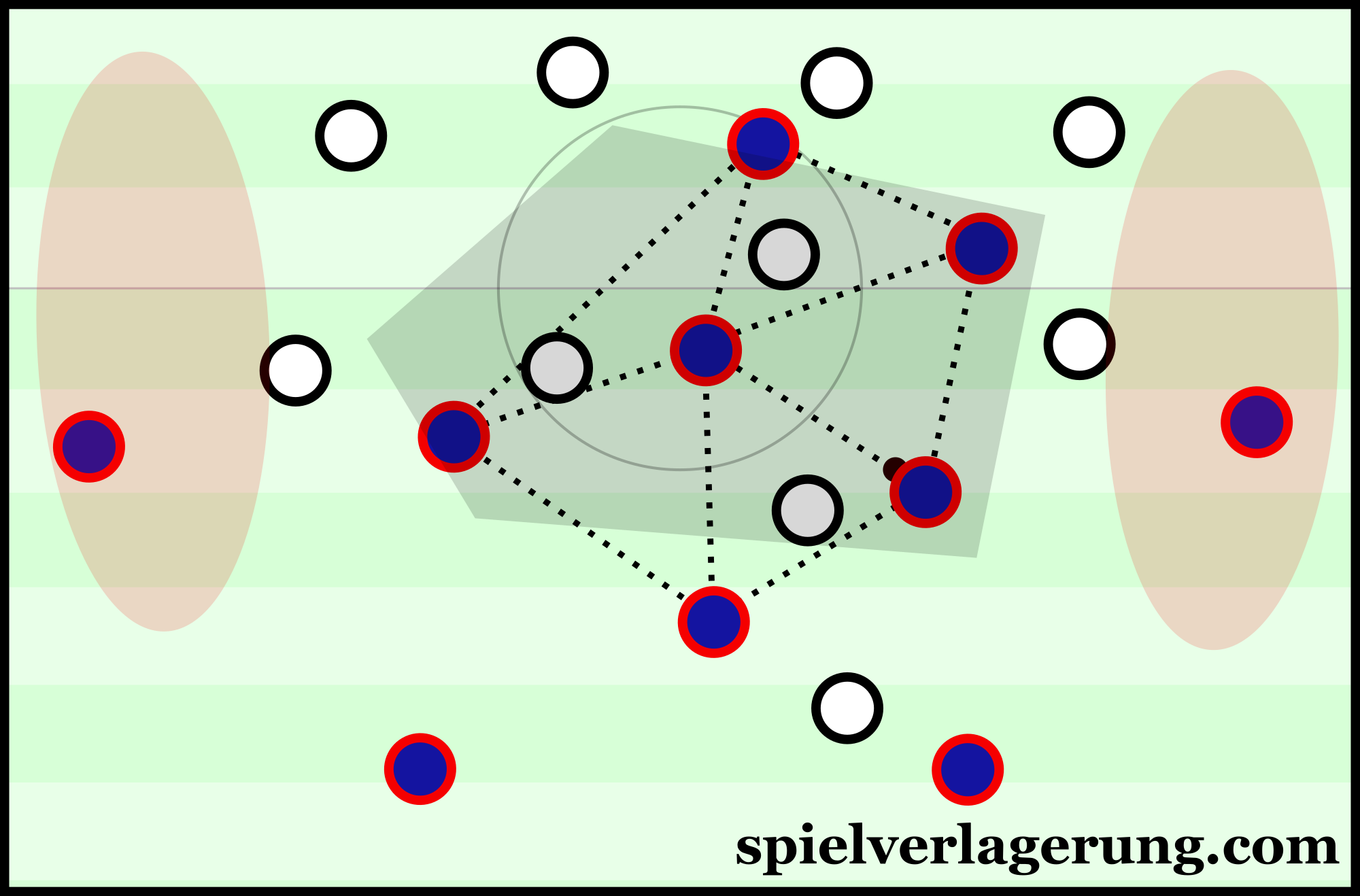
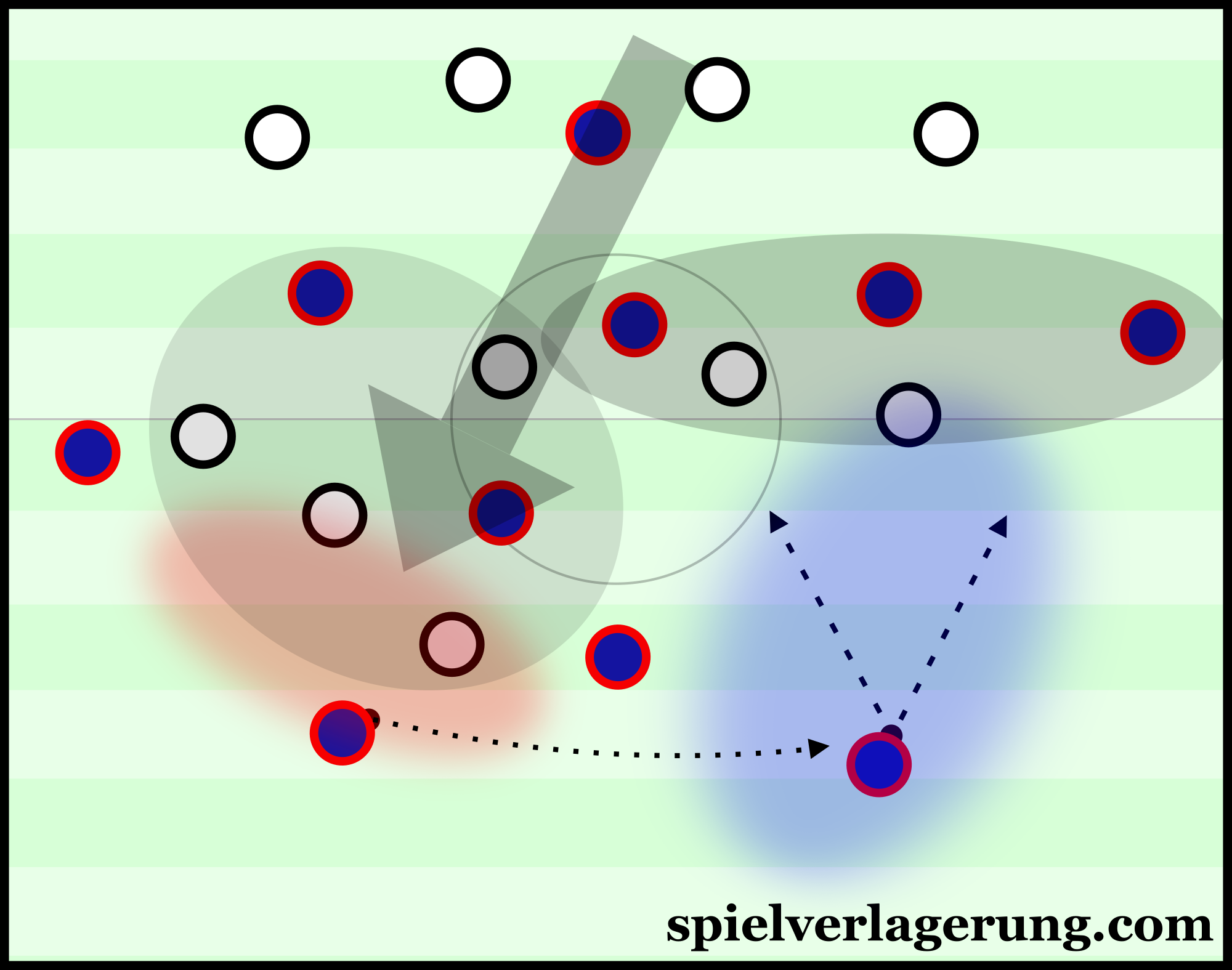
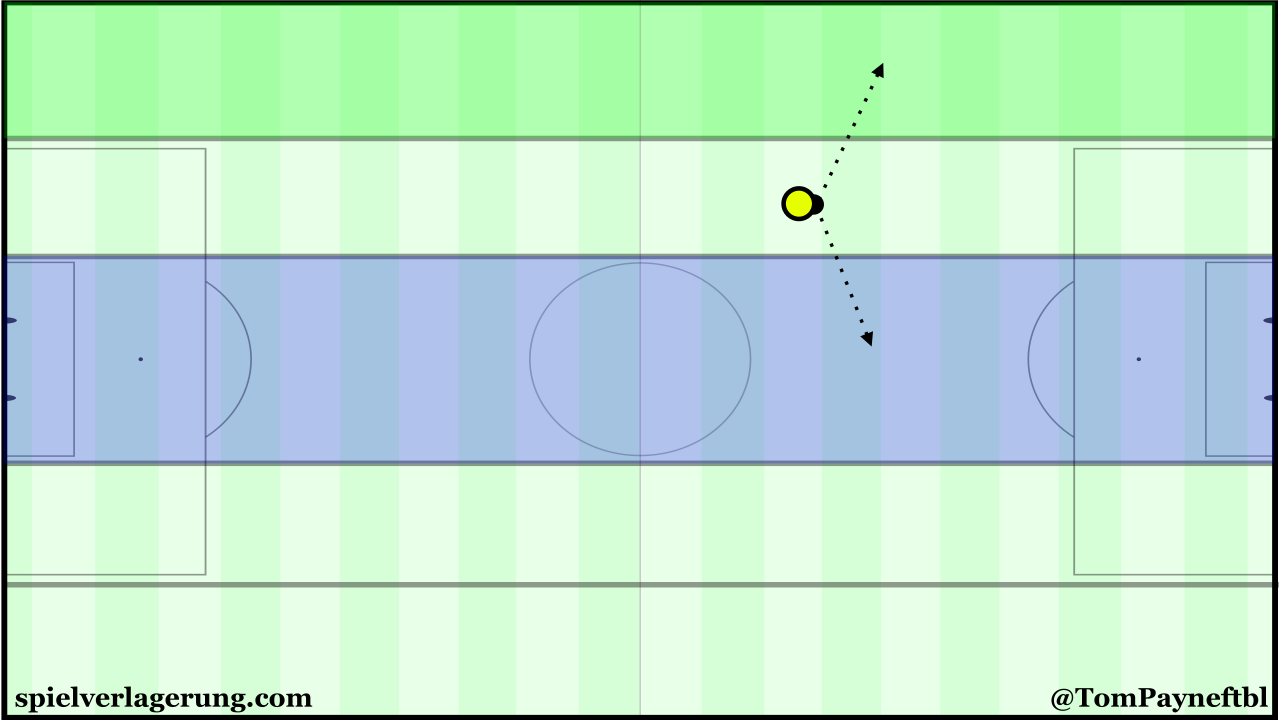
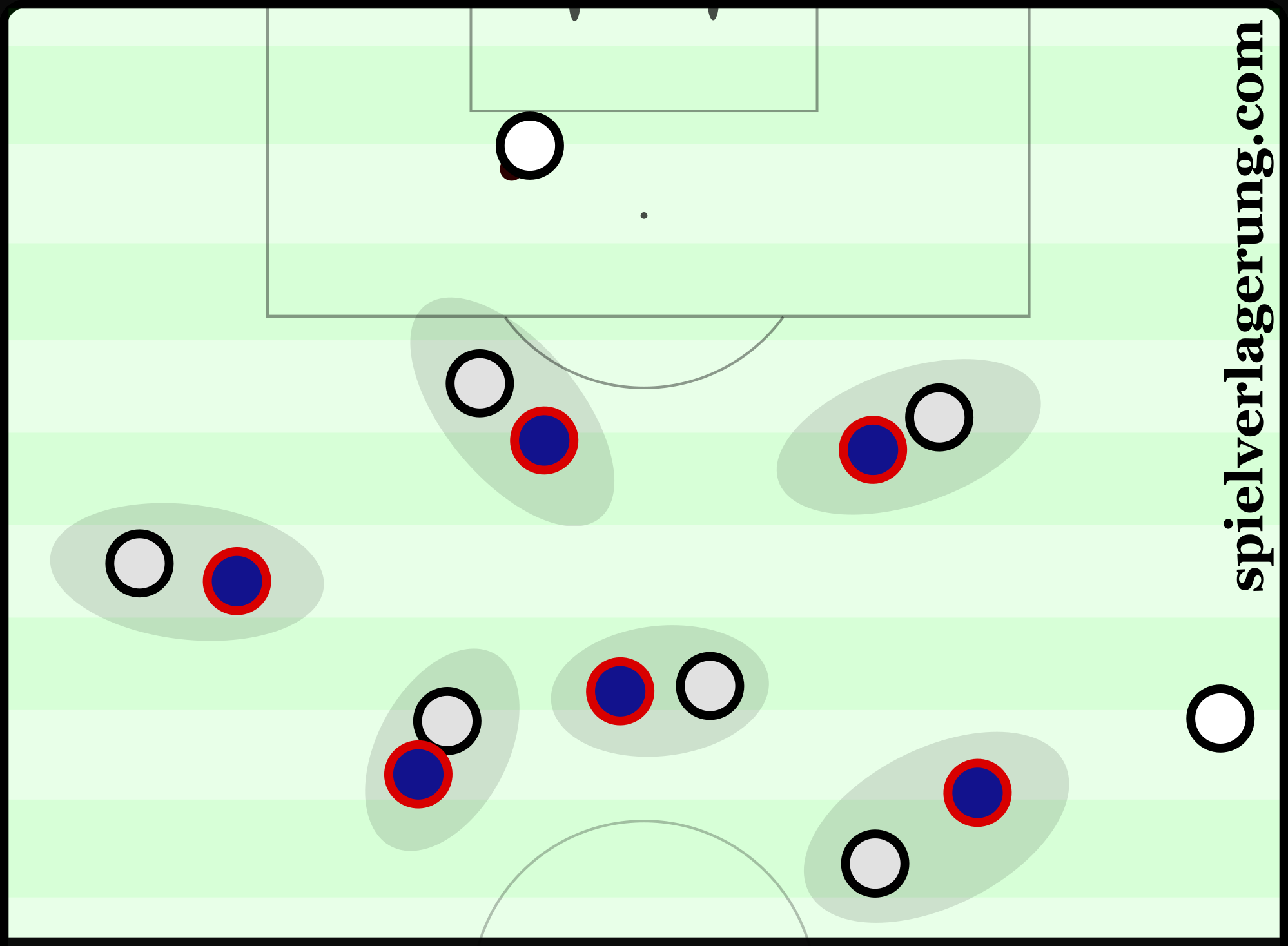

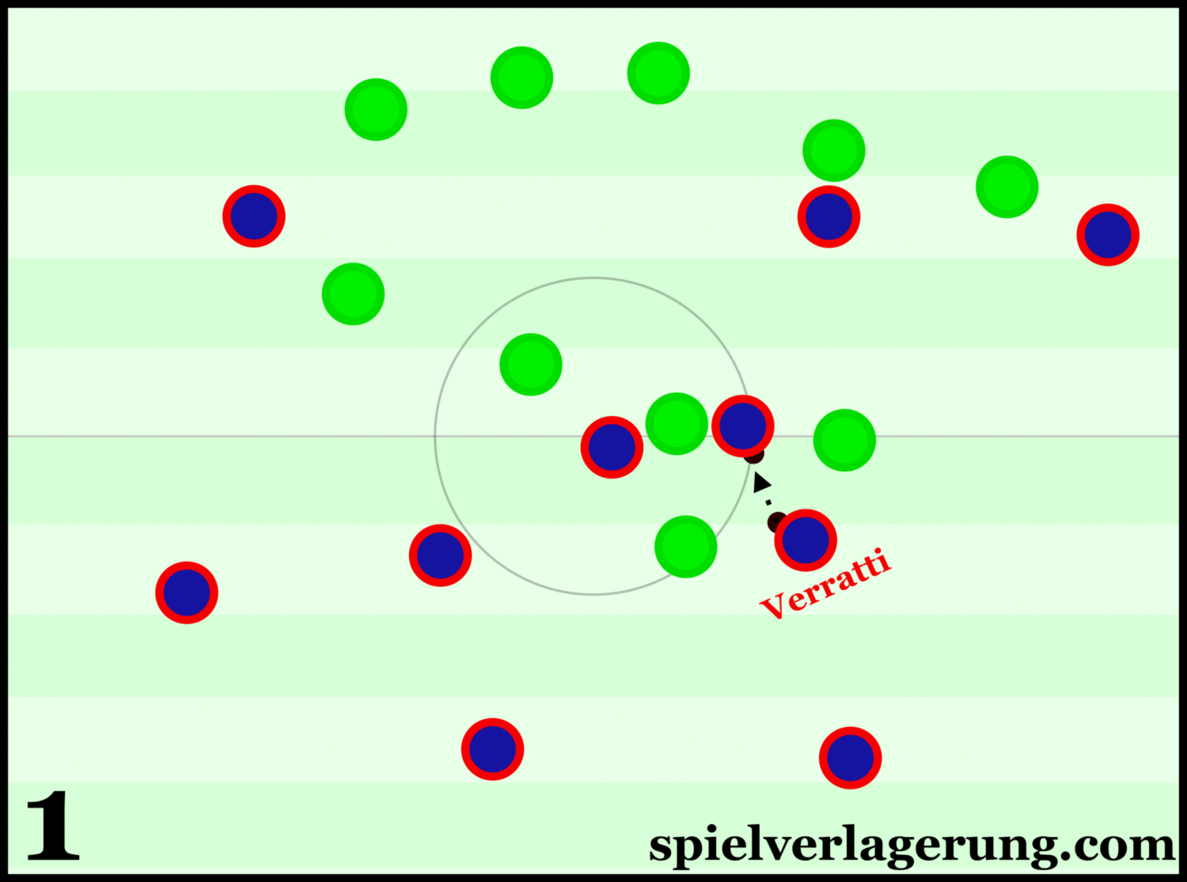
7 Kommentare Alle anzeigen
Joderic February 19, 2016 um 1:28 am
Great analysis! Good job man.
asma’an February 17, 2016 um 11:11 pm
i would love to see you make a team analysis on Juventus this season. It would be amazing!
woody10 February 17, 2016 um 8:34 am
What a great analysis, TP!
RD February 16, 2016 um 9:17 am
Great analysis – am excited for their matchup with Chelsea, whose ability to exploit poor positioning in transition is notable. Curious to see what midfield Hiddink uses with Verratti not expected to feature.
EK February 14, 2016 um 8:03 pm
Thank you very much for this excellent article, much appreciated!
TP February 14, 2016 um 8:56 pm
Thanks for the kind words mate!
smoc February 13, 2016 um 11:03 pm
wow, thanx!